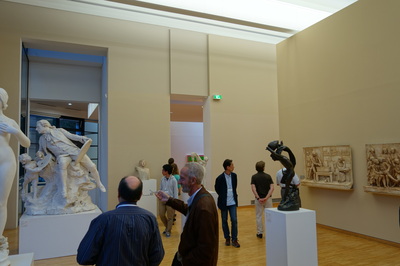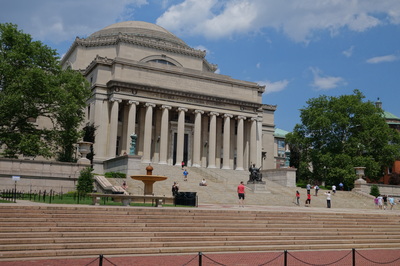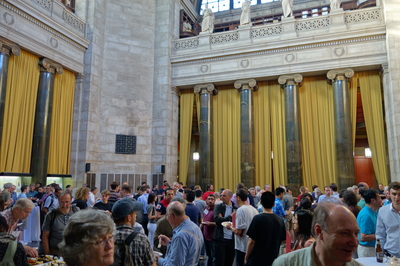Conferences & Schools
| 7th International Workshop on Quantum Compilation Speaker, 06/09/2025 - 07/09/2025 (upcoming) Helsinki, Finland |
| New frontiers in out-of-equilibrium quantum many-body dynamics Poster, 11/08/2025 - 15/08/2025 MPI-PKS, Dresden, Germany |
| Quantum Physics and Logic Participant, 14/07/2025 - 18/07/2025 Varna, Bulgaria |
| Localization: Emergent Platforms and Novel Trends Speaker, 16/09/2024 - 20/09/2024 MPI-PKS, Dresden, Germany |
| Driven Quantum Systems Participant, 18/03/2024 - 20/03/2024 IHP Paris, France |
| Dynamics of Monitored Quantum Many-Body
Systems Speaker, 21/08/2023 - 25/08/2023 ICTP Trieste, Italy |
| Localisation 2022 Speaker, 25/08/2022 - 30/08/2022 Hokkaido University, Sapporo, Japan |
| International Quantum Tensor Network: Inaugural Meeting Participant, 27/06/2022 - 29/06/2022 University College London |
| Quantum Matter International Conference – QUANTUMatter 2022 Poster, 21/06/2022 - 23/06/2022 Barcelona, Spain |
| Condensed Matter and Quantum Materials (CMQM) 2022 Speaker, 20/06/2022 - 22/06/2022 University of Bath |
| Condensed Matter Physics in the City: London 2022 Speaker, 06/06/2022 - 18/06/2022 University College London |
| Quantum Information Entropy in Physics Participant, 22/03/2022 - 25/03/2022 Yukawa Institute for Theoretical Physics, Kyoto University |
| Ergodicity Breaking and Anomalous Transport in Quantum Many-Body Systems Speaker, 04/10/2021 - 08/10/2021 MPI-PKS, Dresden, Germany |
| KITP Conference: Non-Equilibrium Universality in Many-Body Physics Participant, 27/09/2021 - 30/09/2021 Kavli Institute for Theoretical Physics, University of California, Santa Barbara, US |
| Modern Developments in Quantum Chaos Speaker, 20/09/2021 - 24/09/2021 Physikzentrum Bad Honnef |
| Condensed Matter Physics in the City: Online 2021 Speaker, 28/06/2021 - 09/07/2021 Hubbard Theory Consortium |
| Theory of Condensed Matter 2021 Participant, 10/06/2021 University of Warwick |
| Online Workshop: Entanglement in Strongly Correlated Systems Participant, 15/02/2021 - 26/02/2021 Organised by Centro de Ciencias de Benasque Pedro Pascual |
| Virtual Meeting: New perspectives on quantum many-body chaos Participant, 08/02/2021 - 11/02/2021 Organised by the Royal Society |
| Virtual Meeting: Many-Body Physics in Open Quantum Systems Participant, 21/01/2021 - 29/01/2021 Organised by Princeton Center for Theoretical Science |
| Virtual Conference: Frontiers of Quantum Computing and Quantum Dynamics Participant, 19/10/2020 - 20/10/2020 Organised by Kavli Institute for Theoretical Physics, University of California, Santa Barbara, US |
| Virtual Workshop: Dynamics, criticality, and universality in random quantum circuits Participant, 30/09/2020 - 02/10/2020 Organised by MPI-PKS, Dresden, Germany |
| Virtual Workshop: Fundamental Aspects of Statistical Mechanics and the Emergence of Thermodynamics in Non-Equilibrium Systems Speaker, 21/09/2020 - 23/09/2020 Organised by DFG Research Unit FOR2692, Germany (Bielefeld University, Forschungszentrum Jülich, Oldenburg University, and Osnabrück University) Program and list of abstracts: HERE. |
| Virtual Conference: Localisation 2020 Speaker, 24/08/2020 - 29/08/2020 Organised by Hokkaido University, Japan Topics:
Talk: Measurement-induced transition in random quantum circuits: from stroboscopic to continuous |
| Virtual International Workshop: Real-time Dynamics in Strongly Correlated Quantum Matter Participant, 08/04/2020 - 09/04/2020 Organised by MPI-PKS, Dresden, Germany |
| Online workshop: Many-body physics out of equilibrium Participant, 24/03/2020 Organised by MPI-PKS, Dresden, Germany |
| Physics by the Lake 2019 Tutor & presenter, 12/08/2019 - 16/08/2019 Venue: The University of Stirling, Stirling, UK Talk: Localisation, ergodicity, and quantum measurements |
| Topological Quantum Matter: From Low-Temperature Physics to Non-Equilibrium Dynamics Participant, 05/08/2019 - 09/08/2019 Venue: Nordita, Stockholm Talk: Entanglement transition from variable-strength weak measurements |
| School and Conference on Complex Quantum Systems out of Equilibrium in Many-Body Physics and Beyond Participant, 27/05/2019 - 07/06/2019 Venue: Yerevan State University, Yerevan, Armenia |
| Conference on Quantum Measurement: Fundamentals, Twists, and Applications Participant, 29/04/2019 - 04/05/2019 Venue: ICTP, Trieste, Italy Topics:
|
| Summer School on Collective Behaviour in Quantum Matter Participant, 27/08/2018 - 14/09/2018 Venue: ICTP, Trieste, Italy Topics: Lecturers: |
| Lancaster Probability Days 2018 Participant, 22/05/2018 - 24/05/2018 Venue: Postgraduate Statistics Centre, Lancaster, UK Topics:
|
| Topological Matter in Artificial Gauge Fields Participant, 26/02/2018 - 02/03/2018 Venue: Max Planck Institute for the Physics of Complex Systems, Dresden, Germany Topics:
|
| 2017 Arnold Sommerfeld School: Numerical methods for correlated many-body systems Participant, 11/09/2017 - 15/09/2017 Venue: Arnold Sommerfeld Center for Theoretical Physics, LMU, Munich, Germany Lecturers (and preliminary topics):
|
| International Conference on Strongly Correlated Electron Systems 2017 (SCES2017) Participant, 16/07/2017 - 21/07/2017 Venue: Clarion Congress Hotel Prague, Prague, Czech Republic Poster: Charge-density-wave phases of a one-dimensional model with long-range repulsive interactions |
| The 35th International Symposium on Lattice Field Theory (Lattice 2017) Participant, 18/06/2017 - 24/06/2017 Venue: Palacio de Congresos de Granada, Granada, Spain Poster: Charge-density-wave phases of a one-dimensional model with long-range repulsive interactions Abstract: We construct a matrix product operator representation of the Hamiltonian of the t-V model. Using the matrix product states (MPS) approach we go beyond the atomic limit, where the phase diagrams are much richer. MPS method is especially problematic near the transition between two different charge-density-wave phases and we show how the bond dimension must be increased in order to converge the results. Our results indicate that the number of possible insulating phases grows with both the maximum interaction range and the fermion density and may cause the loss of insulating properties of the material at finite temperatures. References: |
| N8 HPC Network Event - New approaches to atomistic / quantum simulation of materials Speaker, 07/01/2017 Venue: The Bar Convent, York, UK Talk: Effects of strain in graphene/hexagonal-boron-nitride heterostructures |
| The 34th International Symposium on Lattice Field Theory (Lattice 2016) Participant, 24/07/2016 - 30/07/2016 Venue: University of Southampton, Southampton, UK Poster: Fermions with long-range interactions using a matrix-product-states approach Abstract: References: |
| NoWNano Summer Conference 2016 Speaker, 27/06/2016 - 30/06/2016 Venue: Cranage Hall, Cheshire, UK Talk: Diffusion Monte Carlo study of charge carrier complexes in two-dimensional semiconductors |
| CPP5 and N8 HPC Network Event - New approaches to atomistic / quantum simulation of materials Speaker, 08/01/2016 Venue: The Bar Convent, York, UK Talk: Diffusion Monte Carlo study of charge carrier complexes in two-dimensional semiconductors |
| Psi-k 2015 Conference Speaker, 06/09/2015 - 11/09/2015 Venue: Kursaal Event Centre, San Sebastian / Donostia, Spain Talk: Diffusion Monte Carlo study of charge carrier complexes in two-dimensional semiconductors Abstract: |
| The 33rd International Symposium on Lattice Field Theory (Lattice 2015) Participant, 13/07/2015 - 18/07/2015 Venue: Kobe International Conference Center, Kobe, Japan Poster: Strong coupling expansion of the $t$-$V$ model (further results) Abstract: References: |
| Tensor Network Summer School 2015 Participant, 01/06/2015 - 05/06/2015 Venue: Ghent University, Ghent, Belgium Topics:
|
| International Conference on Strongly Correlated Electron Systems 2014 Participant, 07/07/2014 - 11/07/2014 Venue: Campus Saint Martin d'Heres, Grenoble, France Poster: Generalised $t$-$V$ model in one dimension Abstract: References: |
| The 32nd International Symposium on Lattice Field Theory (Lattice 2014) Speaker, 22/06/2014 - 28/06/2014 Venue: Columbia University, New York, US Talk: Lattice Hamiltonian approach to the Schwinger model Abstract: |
| NoWNano Summer Conference 2014 Participant, 09/06/2014 - 11/06/2014 Venue: Cranage Hall, Cheshire, UK |
| NoWNano Summer Conference 2013 Participant, 17/06/2013 - 20/06/2013 Venue: Cranage Hall, Cheshire, UK |
The 34th International Symposium on Lattice Field Theory (Lattice 2016)
Participant, 24/07/2016 – 30/07/2016
Venue: University of Southampton, Southampton, UK
Poster: Fermions with long-range interactions using a matrix-product-states approach
M. Szyniszewski
Abstract:
The long-range t-V model of fermions on a lattice is known to exhibit a transition between a Luttinger liquid phase and a Mott insulator phase [1]. At insulating densities, one can tailor the potential energy of the model in such a way that one forces a quantum phase transition to either another insulating charge-density-wave phase, a bond-order phase or a Luttinger liquid [2]. We show how to construct a matrix product operator representation of the Hamiltonian of the t-V model and we present phase diagrams calculated using the matrix-product-states approach [3]. We compare these phase diagrams with results obtained in the atomic limit.
| References: [1] G. Gómez-Santos, Phys. Rev. Lett. 70, 3780 (1993). [2] P. Schmitteckert and R. Werner, Phys. Rev. B 69, 195115 (2004); T. Mishra et al., Phys. Rev. B 84, 115135 (2011). [3] D. Perez-Garcia et al., Quantum Inf. Comput. 7, 401 (2007); F. Verstraete et al., Adv. Phys. 57, 143 (2008). | POSTER |
NoWNano Summer Conference 2016
Speaker, 27/06/2016 – 30/06/2016
Venue: Cranage Hall, Cheshire, UK
Talk: Diffusion Monte Carlo study of charge carrier complexes in two-dimensional semiconductors
M. Szyniszewski, E. Mostaani, C. Price, R. Maezono, N. Drummond, V. Fal’ko
N8 HPC Network Event – New approaches to atomistic / quantum simulation of materials
Speaker, 08/01/2016
Venue: The Bar Convent, York, UK
Talk: Diffusion Monte Carlo study of charge carrier complexes in two-dimensional semiconductors
M. Szyniszewski, E. Mostaani, C. Price, R. Maezono, N. Drummond, V. Fal’ko
Psi-k 2015 Conference
Speaker, 06/09/2015 – 11/09/2015
Venue: Kursaal Event Centre, San Sebastian / Donostia, Spain
Talk: Diffusion Monte Carlo study of charge carrier complexes in two-dimensional semiconductors
M. Szyniszewski, E. Mostaani, N. Drummond, V. Fal’ko
Abstract:
We use a novel description of the interaction between charges in two-dimensional (2D) semiconductors to investigate the binding properties of two-, three- and four-particle complexes of charge carriers (excitons, trions and biexcitons). We report binding energies and pair distribution functions calculated using diffusion quantum Monte Carlo methods, which are exact for these systems. Our results will enable the interpretation of experimental photoabsorption and photoluminescence measurements on 2D transition-metal dichalcogenide materials. We show that our data are consistent with previous binding-energy data for the limits in which the interactions between charges reduce to logarithmic and Coulomb (1/r) forms. We find that the logarithmic interaction that has previously been used to study excitons and trions in 2D semiconductors provides an inadequate description of the behaviour of systems such as molybdenum disulphide, and we provide accurate binding-energy data for excitons, trions and biexcitons in these materials.
Grant: IOP Research Student Conference Fund awarded by IOP Computational Physics Group; Psi-k Conference Financial Support.PRESENTATION





The 33rd International Symposium on Lattice Field Theory (Lattice 2015)
Participant, 13/07/2015 – 18/07/2015
Venue: Kobe International Conference Center, Kobe, Japan
Poster: Strong coupling expansion of the t-V model (further results)
M. Szyniszewski, E. Burovski
Abstract:
We employ a strong coupling expansion – similar to the one used in the lattice field theory studies [1] – to solve the one-dimensional extended t-V model of fermions on a lattice [2]. This model is solved for a range of filling factors, including both commensurate – where a charge density wave is present – and incommensurate densities. The first set consists not only of a trivial case of half filling. The method allows us to trace the transition from a Luttinger liquid phase to a Mott insulating phase and calculate the critical parameter K. This simple yet powerful method is not based on Bethe ansatz and it works for both integrable and non-integrable systems. Furthermore, we investigate how tailoring the interaction can introduce other ordered phases of the system [3].
| References: [1] C.J. Hamer, Phys. Lett. B 82, 75-78 (1979); D.P. Crewther, C.J. Hamer, Nucl. Phys. B 170, 353-368 (1980). [2] G. Gómez-Santos, Phys. Rev. Lett. 70, 3780 (1993); R.G. Dias, Phys. Rev. B 62, 7791 (2000). [3] P. Schmitteckert, R. Werner, Phys. Rev. B 69, 195115 (2004); T. Mishra et al., Phys. Rev. B 84, 115135 (2011). | POSTER |










Tensor Network Summer School 2015
Participant, 01/06/2015 – 05/06/2015
Venue: Ghent University, Ghent, Belgium
Topics:
– matrix product states (MPS)
– projected entangled pair states (PEPS)
– multiscale entanglement renormalization ansatz (MERA)
Travel grant: Lancaster University Graduate School Travel Grant GSTG-15-76.




International Conference on Strongly Correlated Electron Systems 2014
Participant, 07/07/2014 – 11/07/2014
Venue: Campus Saint Martin d’Hères, Grenoble, France
Poster: Generalised t-V model in one dimension
M. Szyniszewski, E. Burovski
Abstract:
We use a strong coupling expansion [1] to solve the one-dimensional extended t‑V model of fermions [2,3]. The model is solved for a range of densities, including both commensurate – where a charge density wave is present – and incommensurate densities. The first set consists not only of a trivial case of half filling. The method allows us to trace the transition from a Luttinger liquid phase to a Mott insulating phase. This simple yet powerful method is not based on Bethe ansatz and it works for both integrable and non-integrable systems.
| References: [1] C.J. Hamer, Phys. Lett. B, 82, 75-78 (1979). [2] G. Gómez-Santos, Phys. Rev. Lett., 70, 3780 (1993). [3] R.G. Dias, Phys. Rev. B, 62, 7791 (2000). | POSTER |
Travel grant: Lancaster University Graduate School Travel Grant GSTG-14-26.





The 32nd International Symposium on Lattice Field Theory (Lattice 2014)
Speaker, 22/06/2014 – 28/06/2014
Venue: Columbia University, New York, US
Talk: Lattice Hamiltonian approach to the Schwinger model
K. Cichy, A. Kujawa-Cichy, M. Szyniszewski
Abstract:
We employ exact diagonalization with strong coupling expansion to the massless and massive Schwinger model. For the massless case, this allows us for a high accuracy continuum limit estimation of the ground state energy and scalar and vector mass gaps with precisions of the order of one part per billion or better. Furthermore, we investigate the chiral condensate and compare our calculations to previous results available in the literature. Oscillations of the chiral condensate which are present while increasing the expansion order are also studied and are shown to be directly linked to the presence of flux loops in the system.
PRESENTATION








| NoWNano Summer Conference 2014 Participant, 09/06/2014 – 11/06/2014 Venue: Cranage Hall, Cheshire, UK | POSTER |
| NoWNano Summer Conference 2013 Participant, 17/06/2013 – 20/06/2013 Venue: Cranage Hall, Cheshire, UKPOSTER |
Outreach Events
| British Science Week Organiser, 18/03/2015 Sackville Street Building, University of Manchester Activities:
 |
| Science Spectacular Organiser, 25/10/2014 Whitworth Hall / Museum, University of Manchester Activities:
   |
| National Science and Engineering Week Organiser, 21/03/2014 Sackville Street Building, University of Manchester Activities:
 |
| Meet the Nanoscientist Organiser, 09/02/2013 Museum of Science and Industry, Manchester Activities:
 |